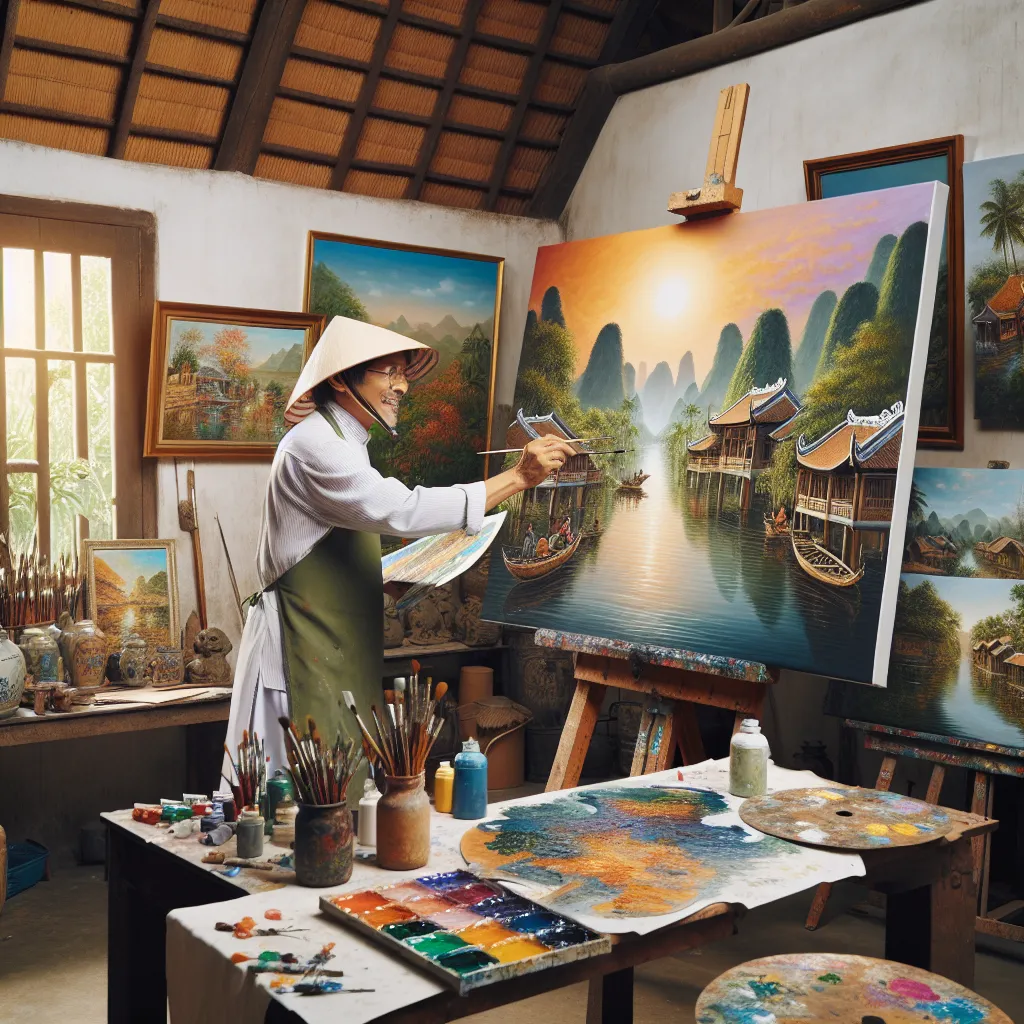Are you preparing for the IELTS Speaking test and wondering how to tackle questions about famous artists or painters in your country? This comprehensive guide will provide you with valuable insights, sample answers, and expert tips to help you excel in this topic. Whether you’re aiming for a Band 6-7 or aspiring to achieve a Band 8-9, we’ve got you covered!
Understanding the Topic: Famous Artists or Painters
Before we dive into the specifics, let’s explore why this topic is important for IELTS Speaking. Questions about famous artists or painters are common in IELTS Speaking tests, as they allow examiners to assess your ability to discuss cultural aspects of your country, express opinions, and use descriptive language.
 Famous artist painting
Famous artist painting
Part 1: Introduction and Interview
In this section, the examiner may ask you general questions about art and artists. Here are some potential questions and sample answers:
Question: Do you enjoy looking at paintings?
Band 6-7 Answer:
Yes, I do enjoy looking at paintings. I find it relaxing and interesting to see different styles and techniques used by artists. Sometimes I visit art galleries in my city to see new exhibitions.
Band 8-9 Answer:
Absolutely! I’m quite passionate about visual arts, particularly paintings. I find it captivating to observe the diverse styles, techniques, and emotional expressions conveyed through different artworks. Whenever possible, I make it a point to visit local galleries and museums to immerse myself in new exhibitions and broaden my artistic horizons.
Question: Do you have a favorite painter?
Band 6-7 Answer:
Yes, my favorite painter is Nguyen Phan Chanh. He’s a famous Vietnamese artist known for his silk paintings. I really like his style and the way he portrays traditional Vietnamese life.
Band 8-9 Answer:
Indeed, I have a particular admiration for Nguyen Phan Chanh, a renowned Vietnamese artist who gained recognition for his exquisite silk paintings. His work profoundly resonates with me due to its nuanced portrayal of traditional Vietnamese life and culture. Chanh’s ability to capture the essence of our heritage through his unique style and choice of medium is truly awe-inspiring.
Part 2: Long Turn (Cue Card)
In this section, you’ll be given a cue card with a topic to speak about for 1-2 minutes. Here’s a sample cue card related to describing a famous artist or painter:
Describe a famous artist or painter from your country
You should say:
- Who this person is
- What kind of art they create
- How you learned about this artist
- And explain why you think they are famous
Sample Answer (Band 8-9):
I’d like to talk about Bui Xuan Phai, a highly esteemed Vietnamese painter who left an indelible mark on the art scene of our country. Phai is primarily renowned for his captivating oil paintings that depict the old streets of Hanoi, capturing the essence of the city’s architecture and daily life.
Phai’s artworks are characterized by their unique style, which blends traditional Vietnamese aesthetics with modern artistic techniques. His paintings often feature muted colors and simplified forms, yet they manage to convey a profound sense of nostalgia and cultural identity. The “Street Paintings” series, for which he is most famous, showcases the charm and character of Hanoi’s old quarter, with its narrow alleys, French colonial buildings, and bustling street life.
I first learned about Bui Xuan Phai during an art history class in high school. Our teacher introduced us to his works and explained his significance in Vietnamese art. Since then, I’ve developed a deep appreciation for his paintings and have visited several exhibitions featuring his work.
Phai’s fame, I believe, stems from his ability to encapsulate the soul of Hanoi and, by extension, Vietnam itself in his paintings. His work resonates deeply with Vietnamese people as it evokes a sense of nostalgia for a bygone era while also celebrating the enduring spirit of our culture. Moreover, his unique style has influenced many contemporary Vietnamese artists, cementing his legacy in the country’s art history.
Phai’s contributions to Vietnamese art have been widely recognized, both nationally and internationally. His paintings are highly sought after by collectors and have been exhibited in prestigious galleries worldwide, further solidifying his reputation as one of Vietnam’s most important artists of the 20th century.
Follow-up Questions
- How has this artist influenced modern Vietnamese art?
Band 8-9 Answer: Bui Xuan Phai has profoundly influenced modern Vietnamese art in several ways. His distinctive style, which seamlessly blends traditional and modern elements, has inspired a whole generation of artists to explore new ways of expressing Vietnamese identity through art. Many contemporary painters have adopted aspects of his technique, particularly his use of simplified forms and muted colors to convey emotion and atmosphere. Furthermore, Phai’s focus on urban landscapes and everyday life scenes has encouraged other artists to find beauty and meaning in the ordinary, leading to a resurgence of interest in depicting Vietnamese cityscapes and street scenes.
- Do you think it’s important for a country to promote its artists internationally?
Band 8-9 Answer: Absolutely, I believe it’s crucial for a country to promote its artists on the international stage. This promotion serves multiple purposes. Firstly, it helps to showcase the country’s cultural richness and diversity to a global audience, fostering greater understanding and appreciation of its heritage. Secondly, international recognition can provide valuable opportunities for artists to collaborate, exchange ideas, and expand their artistic horizons. This cross-cultural interaction can lead to innovative artistic expressions that enrich both the local and global art scenes. Moreover, promoting artists internationally can have significant economic benefits, boosting cultural tourism and creating new markets for the country’s art. Ultimately, it contributes to the nation’s soft power and cultural diplomacy, enhancing its global image and influence.
Part 3: Two-way Discussion
In this section, the examiner will ask you more abstract questions related to the topic. Here are some potential questions and sample answers:
Question: How do you think technology is changing the way we create and appreciate art?
Band 8-9 Answer: Technology is revolutionizing both the creation and appreciation of art in profound ways. On the creation side, digital tools and software have opened up new avenues for artistic expression, allowing artists to experiment with mediums that were previously impossible. For instance, digital art, 3D modeling, and virtual reality installations are pushing the boundaries of what we consider art.
In terms of appreciation, technology has democratized access to art like never before. Virtual museum tours, high-resolution digital reproductions, and online galleries have made it possible for people around the world to engage with artworks they might never have seen otherwise. This increased accessibility is fostering a global conversation about art and breaking down barriers between different artistic traditions.
However, it’s important to note that while technology offers new possibilities, it also raises questions about authenticity and the value of physical artwork. The rise of NFTs (Non-Fungible Tokens) in the art world, for example, is challenging traditional notions of ownership and value in art.
Overall, I believe technology is enhancing our relationship with art, making it more interactive, accessible, and diverse, while also presenting new challenges that are reshaping the art world as we know it.
Question: Do you think the government should provide financial support to artists? Why or why not?
Band 8-9 Answer: This is a complex issue with valid arguments on both sides. On one hand, government support for artists can be crucial in nurturing a country’s cultural landscape. Financial assistance, such as grants, subsidies, or public commissions, can provide artists with the means to create without being entirely beholden to market forces. This support can foster innovation and allow for the creation of art that might not be immediately commercially viable but has significant cultural or artistic merit.
Moreover, government funding can help preserve traditional art forms that might otherwise be lost in a purely market-driven environment. It can also support arts education and public access to art, which are vital for cultivating appreciation and understanding of art in society.
On the other hand, there are concerns that government funding might lead to political interference in artistic expression or create a dependency that could stifle creativity. Some argue that art should be self-sustaining and that market forces should determine which art thrives.
Personally, I believe a balanced approach is ideal. Government support should exist, particularly for arts education, public art projects, and preserving cultural heritage. However, this support should be structured in a way that maintains artistic independence and complements, rather than replaces, other sources of funding. The goal should be to create an environment where diverse forms of artistic expression can flourish, contributing to a rich and vibrant cultural landscape.
Key Vocabulary and Phrases for High Scores
To enhance your speaking performance, incorporate these sophisticated words and phrases:
-
Indelible mark (adjective + noun) – /ɪnˈdelɪbl mɑːrk/ – A lasting impression or effect
Example: The artist’s unique style left an indelible mark on the art world. -
Captivating (adjective) – /ˈkæptɪveɪtɪŋ/ – Fascinating or attractive
Example: Her captivating paintings draw viewers into a world of vibrant colors and emotions. -
Nuanced (adjective) – /ˈnjuːɑːnst/ – Characterized by subtle shades of meaning
Example: The artist’s nuanced approach to portraying human emotions sets him apart from his contemporaries. -
Resonate (verb) – /ˈrezəneɪt/ – To evoke a feeling of shared emotion or belief
Example: His paintings resonate deeply with those who have experienced life in rural Vietnam. -
Avant-garde (adjective) – /ˌævɒ̃ˈɡɑːrd/ – New and experimental ideas in art, music, or literature
Example: Her avant-garde sculptures challenge traditional notions of form and space. -
Prolific (adjective) – /prəˈlɪfɪk/ – Producing many works
Example: Despite his short career, he was a prolific artist, creating over 800 paintings.
Expert Advice for IELTS Speaking Success
To excel in the IELTS Speaking test, particularly when discussing famous artists or painters:
-
Develop a broad knowledge base: Familiarize yourself with various artists and art movements, both from your country and internationally.
-
Practice describing visual art: Enhance your descriptive vocabulary by regularly practicing describing paintings or other artworks.
-
Stay informed about current art trends: Keep up with contemporary art scenes and debates to provide insightful answers in Part 3 discussions.
-
Use sophisticated language structures: Incorporate complex sentences and advanced vocabulary to demonstrate your language proficiency.
-
Express personal opinions: Don’t just state facts; share your thoughts and feelings about the art or artist you’re discussing.
-
Make cultural connections: Relate the artist’s work to broader cultural or historical contexts to show depth of understanding.
By following these tips and using the sample answers as inspiration, you’ll be well-prepared to discuss famous artists or painters in your IELTS Speaking test. Remember, practice is key to confidence and fluency. Good luck with your IELTS journey!


